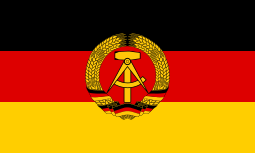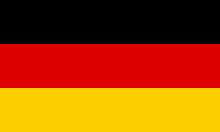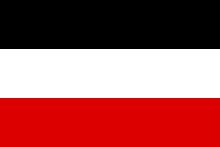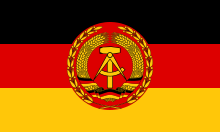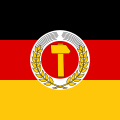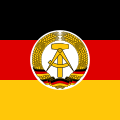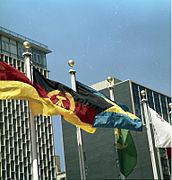
East Germany is the common English name for the historical German state known as the German Democratic Republic (GDR), located in Central Europe from its formation on 7 October 1949 until its reunification with West Germany on 3 October 1990. Until 1989, it was generally viewed as a communist state and described itself as a socialist "workers' and peasants' state". The economy of the country was centrally planned and state-owned. Although the GDR had to pay substantial war reparations to the Soviets, it became the most successful economy in the Eastern Bloc.

A national flag is a flag that represents and symbolizes a given nation. It is flown by the government of that nation, but can also be flown by its citizens. A national flag is typically designed with specific meanings for its colours and symbols, which may also be used separately from the flag as a symbol of the nation. The design of a national flag is sometimes altered after the occurrence of important historical events. The burning or destruction of a national flag is a greatly symbolic act.

The Basic Law for the Federal Republic of Germany is the constitution of the Federal Republic of Germany.

The national flag of Germany is a tricolour consisting of three equal horizontal bands displaying the national colours of Germany: black, red, and gold. The flag was first sighted in 1848 in the German Confederation. The flag was also used by the German Empire from 1848 to 1849. It was officially adopted as the national flag of the German Reich from 1919 to 1933, and has been in use since its reintroduction in Federal Republic of Germany in 1949.

The national flag of Chad is a vertical tricolour consisting of a blue, a gold and a red field. Since the 1990s, its similarity to the flag of Romania has caused international discussion.

German Reich was the constitutional name for the German nation state that existed from 18 January 1871 to 5 June 1945. The Reich became understood as deriving its authority and sovereignty entirely from a continuing unitary German Volk, with that authority and sovereignty being exercised at any one time over a unitary German "state territory" with variable boundaries and extent. Although commonly translated as "German Empire", the word Reich here better translates as "realm" or territorial "reach", in that the term does not in itself have monarchical connotations.

The national flag of the Russian Federation is a tricolour of three equal horizontal bands: white on the top, blue in the middle, and red on the bottom.

The coat of arms of Germany displays a black eagle with a red beak, a red tongue and red feet on a golden field, which is blazoned: Or, an eagle displayed sable beaked langued and membered gules. This is the Bundesadler, formerly known as Reichsadler. It is one of the oldest coats of arms in the world, and today the oldest national symbol used in Europe.

The national emblem of East Germany featured a hammer and a compass, surrounded by a ring of rye. It was an example of what has been called "socialist heraldry". It was the only heraldic device of a European socialist state with a ring of grain which does not contain a red star.

A red star, five-pointed and filled, is a symbol that has often historically been associated with communist ideology, particularly in combination with the hammer and sickle, but is also used as a purely socialist symbol in the 21st century. It has been widely used in flags, state emblems, monuments, ornaments, and logos.

The United Team of Germany was a combined team of athletes from West Germany and East Germany that competed in the 1956, 1960 and 1964 Winter and Summer Olympic Games. In 1956, the team also included athletes from a third Olympic body, the Saarland Olympic Committee, which had sent a separate team in 1952, but in 1956 was in the process of joining the German National Olympic Committee. This process was completed in February 1957 after the admission of Saarland into West Germany.

Athletes from Germany (GER) have appeared in 27 of the 30 Summer Olympic Games, having competed in all Games except those of 1920, 1924 and 1948, when they were not permitted to do so. Germany has hosted the Summer Olympic Games twice; the 1936 Games in Berlin, and the 1972 Games in Munich.

The national colours of the Federal Republic of Germany are officially black, red, and gold, defined with the adoption of the West German flag as a tricolour with these colours in 1949. Germany was divided into West Germany and East Germany from 1949 to 1990, and both Germanies retained the black, red, and gold colors on their respective flags. After German reunification in 1990, the united Germany retained the West German flag, thus retaining black, red, and gold as Germany's colors.

The coat of arms of Berlin is used by the German city state as well as the city itself. Introduced in 1954 for West Berlin, it shows a black bear on a white shield. On top of the shield is a special crown, created by the amalgamation of the mural crown of a city with the so-called people's crown, used in Germany to denote a republic. Berlin's various boroughs use their own emblems.

Athletes from Germany have taken part in most of the modern Olympic Games held since 1896. Germany has hosted three Olympic Games, in 1936 both the Winter and Summer Games, and the 1972 Summer Olympics. In addition, Germany had been selected to host the 1916 Summer Olympics as well as the 1940 Winter Olympics, both of which had to be cancelled due to World Wars. After these wars, Germany was banned from participating in the 1920, 1924 and 1948 Olympics.

The flag of Saarland is based on the flag of Germany and is a black, red, and gold horizontal tricolor. In the center of the flag is the coat of arms of Saarland. The flag of Saarland is both the civil flag, as well as the state service flag.
Communist symbolism represents a variety of themes, including revolution, the proletariat, the peasantry, agriculture, or international solidarity. The red flag, the hammer and sickle and the red star or variations thereof are some of the symbols adopted by communist movements, governments, and parties worldwide.

The Flag of the German Empire, or Imperial Flag, Realm Flag, is a combination between the flag of Prussia and the flag of the Hanseatic League. Starting as the national flag of the North German Confederation, it would go on to be commonly used officially and unofficially under the nation-state of the German Reich, which existed from 1871 to 1945.

The Wirmer Flag, also known commercially as the flag of German Resistance 20 July or the Stauffenberg flag, is a design by Josef Wirmer. Wirmer was a resistance fighter against the Nazi Regime and part of the 20 July plot. According to his idea, the flag was to become the new flag of Germany after the successful assassination attempt against Hitler and the transfer of power to the conspirators. First discussed by the Parlamentarischer Rat in 1948/49 as the federal flag, the design served in modified form as the party flag of the Christian Democratic Union of Germany (CDU) from 1953 until around 1970 and as the model for the Free Democratic Party's (FDP) party symbol. The flag then disappeared from public perception.
